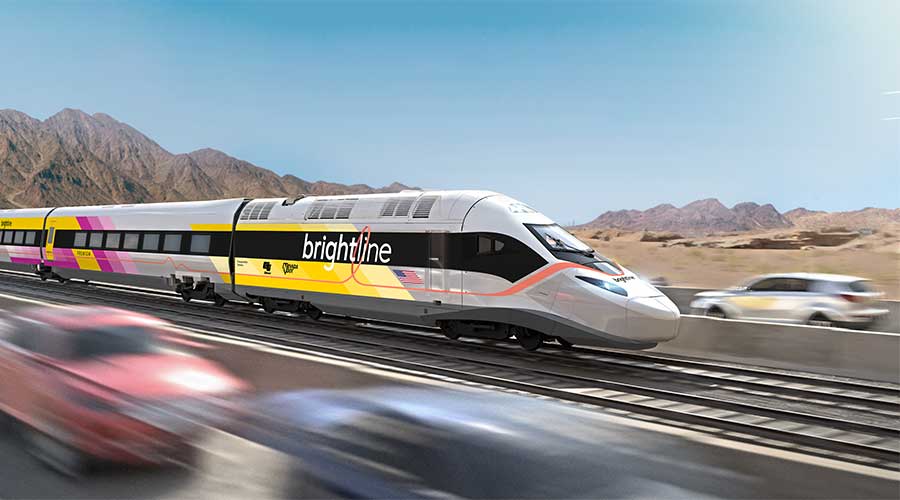Stay updated on news, articles and information for the rail industry
June 2013
Rail News: Passenger Rail
Detroit turns to a streetcar system as a catalyst for urban renewal
By Julie Sneider, Assistant Editor
Detroit may be the historic home of the U.S. automotive industry, but business and community leaders are banking on a new streetcar rail system to help drive the economic revival of Motor City.
It’s been two months since the Federal Transit Administration issued an amended “Record of Decision” indicating the proposed 3.3-mile line along Detroit’s Woodward Avenue corridor had cleared its environmental review. Since then, M-1 Rail — the nonprofit 501(c)(3) organization overseeing the $140 million streetcar project — has been pursuing an aggressive timetable toward a late 2015 service launch.
“We are now jumping out of the gate,” says Heather Carmona, M-1 Rail’s chief administrative officer and one of several executives hired at M-1 Rail in recent months. Bids for the project construction manager and general contractor have been received and an award for the primary contract could be announced any day. Final design could be completed by mid-August. Depending on when the necessary permits are secured, construction could start by summer’s end or early fall, she says.
M-1 Rail officials also are evaluating their approach to securing the six streetcars the system will use. Later this year, they expect to send out a request for proposals for construction of a storage and maintenance facility.
The circulating streetcar — which has yet to be named — initially will operate along Woodward Avenue from the city’s downtown to the Midtown area, then on to the New Center and North End areas. The streetcar will include a stop at an Amtrak station, and M-1 Rail officials hope the line eventually will extend farther north and/or within downtown Detroit. They also anticipate it will connect with a future bus rapid transit system the city is planning. The Southeast Michigan Council of Governments, which is studying additional transit options along Woodward Avenue from downtown Detroit to downtown Pontiac, also is including the streetcar project in its analysis.
Streetcar in the works for years
A Woodward Avenue corridor rail line has been in the planning stages since 2007, when a consortium of local business, philanthropic and community officials concluded Detroit’s status as a “transit-challenged” city had to change as part of a broader plan to stimulate Detroit’s economy, attract new residents and retain a younger generation of workers, says Laura Trudeau, program director for the community development team at the Detroit-based Kresge Foundation.
The foundation, which has committed at least $35 million to M-1 Rail, was one of the rail line’s early advocates.
“We thought for a long time that Detroit as a region doesn’t have a good transit system,” Trudeau says. “We have two separate bus systems, we have no rail and we have no real rapid transit. For a region of 4 million people, that’s just not acceptable anymore.”
Early in their planning, M-1 Rail supporters wanted to develop a rail line that would qualify for federal funding. Given the lengthy grant application process, Detroit-area businesses, foundations and other institutions agreed to put up the money necessary to get it going sooner — and serve as a match for any federal funds that might be granted.
Since then, the project has evolved into an “unprecedented model of public-private will and cooperation,” M-1 officials say. About two-thirds of the streetcar line’s costs will be covered by private funds; the remainder will come from federal, state and local grants, Carmona says. The project’s co-chairmen are Penske Corp. founder Roger Penske and Quicken Loans Inc. founder Dan Gilbert.
Funding commitments of $3 million have come from Wayne State University, Quicken Loans, the Ilitch companies, Penske Corp., Compuware Corp., Chevrolet, Chrysler Group, Blue Cross Blue Shield of Michigan, the Detroit Medical Center, Henry Ford Health System, Wayne County government, the Ford Foundation and W.K. Kellogg Foundation, according to a May 12 article in Crain’s Detroit Business. In addition, the Hudson Webber Foundation has committed $1 million; the Detroit Downtown Development Authority has allotted $9 million.
And in January, U.S. Transportation Secretary Ray LaHood traveled to Detroit to announce that the U.S. Department of Transportation would provide $25 million to M-1 Rail, as well as another $6.5 million for engineering and studies for a regional transportation system under the area’s new Regional Transit Authority.
“This can become a model for the rest of the country, where a community has come together in one of the hardest economic times in U.S. history and put together a program that will benefit its people,” LaHood said of M-1 Rail’s public-private partnership.
The streetcar project planning has taken some twists and turns over the years, including a time when it merged into a city plan to build a 9-mile light-rail line through the corridor. After the city determined the light-rail plan was too expensive, M-1 Rail officials determined they still would pursue the streetcar plan.
Great expectations
Expectations are high for what the streetcar line might do for Detroit’s continuing efforts toward urban renewal. M-1 Rail officials see the streetcar as the “future centerpiece of a seamless transit system” that will connect people to jobs, retail, sporting and cultural activities. About $500 million to $1 billion worth of economic development is anticipated along the Woodward Avenue corridor, and streetcar ridership is estimated at 5,000 to 8,000 riders per day, they say.
“The downtown and Midtown areas have really come back strong in the last five years, and we believe just the promise of a rail line has driven a lot of that development,” says Trudeau.
Some North End neighborhood residents are “cautiously optimistic” that the streetcar will make a positive difference in their community, says Khalilah Gaston, interim executive director of Vanguard Community Development Corp., which was founded in the mid-1990s to revitalize the North End. Gaston partnered with M-1 Rail to organize an initial community meeting to inform residents and business owners of the streetcar project’s potential impact.
North End advocates view M-1 Rail as a catalyst for linking the neighborhood, which has endured a history of “disinvestment,” with other Woodward Avenue corridor neighborhoods that are benefiting from a recovering economy, Gaston says.
Getting the streetcar line built and operating will be a win for the entire city, she adds.
“Detroit is notorious for not having an efficient regional transit system," Gaston says. "This is an opportunity for us to show the rest of the country that public entities, private entities and philanthropy can work together to get things done. Hopefully, M-1 Rail will create the initial momentum needed to link Detroit and the surrounding suburbs through an effective regional transit system.”
Keywords
Browse articles on Detroit Motor City M-1 Rail streetcar Federal Transit Administration Kresge FoundationContact Progressive Railroading editorial staff.


 2025 MOW Spending Report: Passenger-rail programs
2025 MOW Spending Report: Passenger-rail programs
 Gardner steps down as Amtrak CEO
Gardner steps down as Amtrak CEO
 Guest comment: Oliver Wyman’s David Hunt
Guest comment: Oliver Wyman’s David Hunt
 Women of Influence in Rail eBook
Women of Influence in Rail eBook
 railPrime
railPrime








